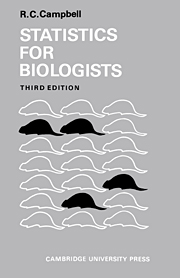Book contents
- Frontmatter
- Contents
- PREFACE
- PREFACE TO SECOND EDITION
- PREFACE TO THIRD EDITION
- 1 WHAT IS STATISTICS ABOUT?
- 2 PRESENTING THE INFORMATION CONTAINED IN ONE SAMPLE
- 3 COMPARING SEVERAL SAMPLES
- 4 ASSOCIATION
- 5 CHOOSING BETWEEN ACTIONS
- 6 THE NORMAL DISTRIBUTION
- 7 THE NORMAL VARIABLE IN EXPERIMENTS AND SURVEYS
- 8 ASSOCIATED NORMAL VARIABLES
- 9 SOME NON-NORMAL DISTRIBUTIONS
- FURTHER READING
- REFERENCES
- APPENDIX: TABLES AND FIGURES FOR STATISTICAL TESTS AND EXERCISES
- INDEX
6 - THE NORMAL DISTRIBUTION
Published online by Cambridge University Press: 05 June 2012
- Frontmatter
- Contents
- PREFACE
- PREFACE TO SECOND EDITION
- PREFACE TO THIRD EDITION
- 1 WHAT IS STATISTICS ABOUT?
- 2 PRESENTING THE INFORMATION CONTAINED IN ONE SAMPLE
- 3 COMPARING SEVERAL SAMPLES
- 4 ASSOCIATION
- 5 CHOOSING BETWEEN ACTIONS
- 6 THE NORMAL DISTRIBUTION
- 7 THE NORMAL VARIABLE IN EXPERIMENTS AND SURVEYS
- 8 ASSOCIATED NORMAL VARIABLES
- 9 SOME NON-NORMAL DISTRIBUTIONS
- FURTHER READING
- REFERENCES
- APPENDIX: TABLES AND FIGURES FOR STATISTICAL TESTS AND EXERCISES
- INDEX
Summary
Why the normal is important
In the preceding chapters the concepts and methods which we have developed have been useful for more or less any form of distribution. The ideas of the histogram and the frequency function as representations of the sample and the population apply for all forms of population. The confidence limits for a median can be used with any distribution, and those for a difference of medians require only that the two distributions are of the same form; this condition is also sufficient for the Mann–Whitney and Wilcoxon procedures and needs only direct extension to cover the cases of more than two populations.
In contrast most of the methods to be discussed in the remaining chapters will require that the populations belong to one special family, known as the normal distribution; such a restriction is in marked contrast to the apparent generality of the earlier discussion, and we must begin by considering why it is introduced. There are two main reasons; one appears to be essentially of a practical nature, whilst the other seems to be theoretical, but in fact they are closely related.
The first reason is that many of the frequency functions applicable to observed distributions do have a normal form; examples of this form are given in Fig. 17. We note at once that they are all symmetrical; each is in fact completely specified when we know its central value and the distance from the central value to the point where the frequency function ceases to curve inwards and begins to curve outwards (the point of inflexion).
- Type
- Chapter
- Information
- Statistics for Biologists , pp. 156 - 198Publisher: Cambridge University PressPrint publication year: 1989



